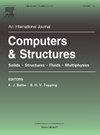流体与大变形运动结构强耦合的CFD-FEM-IBM模拟方案
IF 4.4
2区 工程技术
Q1 COMPUTER SCIENCE, INTERDISCIPLINARY APPLICATIONS
引用次数: 0
摘要
为了描述流体与剧烈变形和大运动的弹性结构之间的强耦合,提出了一种CFD-FEM-IBM模拟方案。流体力学由Navier-Stokes方程控制,而变形结构的高度非线性力学行为采用更新的拉格朗日增量描述来模拟。混合方法的一个突出特点是计算流体动力学和计算固体动力学在有限元框架内进行空间离散化。此外,准确模拟强耦合效应的主要挑战在于描述随时间剧烈变形的流固边界。采用直接强迫浸入边界法处理流固耦合,在结构的可变形表面上分配浸入边界点来表示流固界面。通过多次迭代,保证了IBM的无滑移边界条件和无发散条件。采用分区方法求解耦合系统,并在每个时间步进行迭代,以反映强耦合效应。最后通过基准试验验证了该方法在模拟大变形大运动流固耦合问题中的可靠性和准确性。本文章由计算机程序翻译,如有差异,请以英文原文为准。
A CFD-FEM-IBM simulation scheme for the strong coupling between the fluid and the structure with large deformations and movements
To describe the strong coupling between the fluid and the elastic structure with drastic deformations and large movements, a CFD-FEM-IBM simulation scheme is proposed. The fluid dynamics are governed by the Navier-Stokes equations, while the highly nonlinear mechanical behavior of the deformable structure is simulated using the updated Lagrangian incremental description. An outstanding feature of the hybrid method is that both the computational fluid dynamics and the computational solid dynamics are discretized spatially in the finite element framework. Besides, the main challenge in simulating strong coupling effects accurately lies in describing the fluid–structure boundary which deforms drastically over time. The direct-forcing immersed boundary method is employed to tackle the fluid–structure interaction and immersed boundary points allocated on the deformable surface of the structure are used to represent the fluid–structure interface. Both the no-slip boundary condition and the divergence-free condition for the IBM are ensured thorough several iterations. Moreover, the partitioned approach is utilized to solve the coupling system and iterations are carried out at each time step to reflect strong coupling effects. The reliability and accuracy of the current method in simulating the fluid–structure interaction problems with large deformations and movements are finally validated by benchmark tests.
求助全文
通过发布文献求助,成功后即可免费获取论文全文。
去求助
来源期刊

Computers & Structures
工程技术-工程:土木
CiteScore
8.80
自引率
6.40%
发文量
122
审稿时长
33 days
期刊介绍:
Computers & Structures publishes advances in the development and use of computational methods for the solution of problems in engineering and the sciences. The range of appropriate contributions is wide, and includes papers on establishing appropriate mathematical models and their numerical solution in all areas of mechanics. The journal also includes articles that present a substantial review of a field in the topics of the journal.
 求助内容:
求助内容: 应助结果提醒方式:
应助结果提醒方式:


